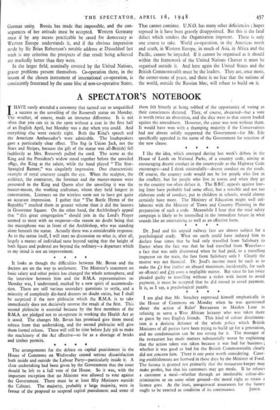A SPECTATOR'S NOTEBOOK
HAVE rarely attended a ceremony that turned out so unqualified I a success as the unveiling of the Roosevelt statue on Monday. The weather, of course, made an immense difference. It is not often that you can sit in the open without a coat in the first half of an English April, but Monday was a day when you could. And everything else went exactly right. Both the King's speech and the American Ambassador's were admirable. The loudspeakers gave a particularly clear effect. The flag (a Union Jack, not the Stars and Stripes, because the gift of the statue was all-British) fell faultlessly as Mrs. Roosevelt pulled the cord. The scene as the King and the President's widow stood together before the unveiled effigy, the King at the salute, while the band played " The Star- Spangled Banner," was singularly impressive. One characteristic example of royal courtesy caught the eye. When the sculptor, the architect, the contractor, the foreman and the master-mason were presented to the King and Queen after the unveiling it was the master-mason, the working craftsman, whom they held longest in conversation, Listeners on the wireless seem not to have got quite an accurate impression. I gather that " The Battle Hymn of the Republic " reached them in greater volume than it did the hearers in Grosvenor Square. On the other hand, the Archbishop's appeal that "this great congregation" should join in the Lord's Prayer seemed to meet with no response—the reason no doubt being that the microphone was in front of the Archbishop, who was standing alone beneath the statue. Actually there was a considerable response. As to the statue itself, I will start no discussion on what is, after all, largely a matter of individual taste beyond saying that the height of both figure and pedestal are beyond the ordinary—a departure which to my mind is not an improvement.






























 Previous page
Previous page